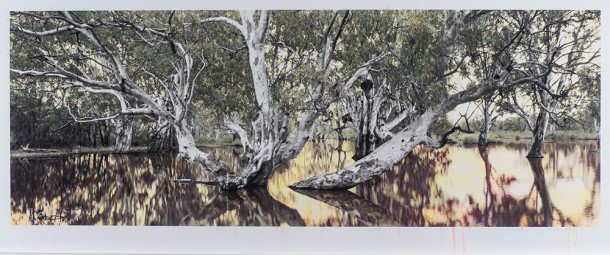
Nici Cumpston belongs to the Barkindji people of the Darling River in northwestern New South Wales. Cumpston’s Listening to the River 2005/2016 is part of her ‘Attesting’ series, which responds to the changing environment of the Murray-Darling Basin due to human intervention.1 In 2007, the Murray’s ecology was disturbed when the Federal Government cut off the water-flow to Nookamka Lake (Lake Bonney). Last year, the Murray-Darling was again in the public eye, as allegations were aired that billions of litres of water had been removed and harvested by irrigators to boost cotton-growing operations upriver.2 Cumpston’s photographs reveal the water system as a site of significance for the Indigenous people associated with it, including her own people. As she explains,
I found out that ancestrally Barkindji people are connected to the River Murray system as well as the Darling River as we used to travel to the inland lakes depending on weather patterns and availability of food sources during different seasons.3
In this photograph, Cumpston documents flooding near Katarapko Creek, around the backwaters of the River Murray, near Gerard Aboriginal Mission in the Riverland of South Australia. This area is lined with tall red river gums, which provide a habitat for biodiversity.4 Describing the site, Cumpston states:
It was during the 10-year drought and I was told that $10K in diesel was spent to pump water into this area in an attempt to give the river red gum forests a chance to be rejuvenated.5
The changed flood patterns of the Murray due to irrigation and interference is in danger of causing either drought or permanent flooding to Katarapko, threatening the survival of the gums and native species.
Following an established practice, Cumpston first photographed the site with black-and-white film, and then hand-coloured with crayon the large-scale prints she produced from it. Through this process of hand-colouring, she highlights the haunting beauty of the lake and its importance as an ecosystem. Listening to the River is also a reminder of the fragility of this environment, and the threats posed to it by human intervention.
Text by Bronte Latcham, Curatorial Volunteer, Emma McLean, Kinnane Endowment Fund Curatorial Intern, and Isabella Baker, Curatorial Assistant.
- ‘Australia’s three longest rivers are found in the Murray-Darling, which include the Darling (2,740 km), the Murray (2,530 km) and the Murrumbidgee (1,690 km). The waters of the northern catchments run to the Darling River and the waters of the southern catchment run to the River Murray’. Refer to: “Geography”, Murray-Darling Basin Authority, https://www.mdba.gov.au/discover-basin/landscape/geography.
- “Murray-Darling Basin: NSW’s most senior water bureaucrat resigns over corruption allegations,” ABC NEWS, http://www.abc.net.au/news/2017-09-15/murray-darling-basin-nsw-top-water-bureaucrat-resigns/8951258.
- Una Rey, “Presences in the land: Nici Cumpston,” Artlink 32, no.2 (2012): 103.
- The gums provide home and shelter for bird species, echidnas and kangaroos, and such rare and threatened species as Sugar Gliders and Carpet Pythons. Refer to: Jodi Frawley, Scott Nichols, Heather Goodall, and Liz Baker, Katarapko: Talking fish: Making connections with the rivers of the Murray-Darling Basin (Canberra: Murray-Darling Basin Authority, 2011), 3.
- Nici Cumpston, email to Samantha Littley, 30 August 2016.
- ‘Katarapko has seen many changes as its waters were blocked, floodplains grazed, and surrounding irrigation districts flourished. Berri Evaporation Basin and Katarapko Island Disposal Basin have both taken a toll as they collected salty irrigation drainage water.’ Refer to: Frawley, Nichols, Goodall, and Baker, Katarapko: Talking fish: Making connections with the rivers of the Murray-Darling Basin, 3.
in site: process, performance, documentation will run from 10 March to 5 August 2018 at UQ Art Museum.



